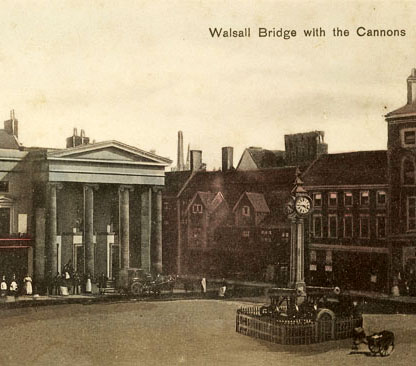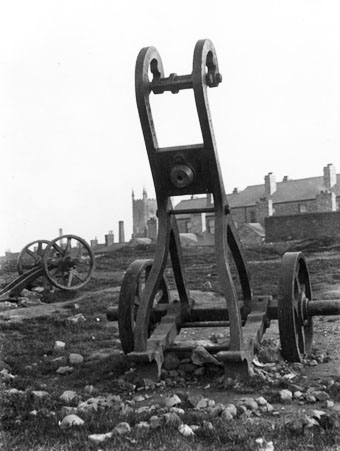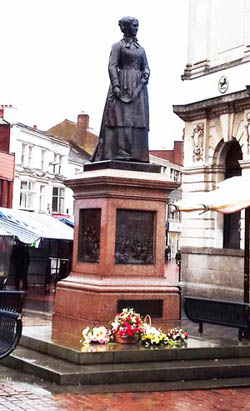|

 CRIMEAN CANNONS - WHERE ARE THEY NOW?
CRIMEAN CANNONS - WHERE ARE THEY NOW?
The Bridge
Walsall
Staffordshire
Great Britain
WS1 1LQ
Sister Dora replaces Guns
In the mid 19th century the town centre shifted westwards to the bridge and Park Street. Part of the water-course by the bridge had been covered over c. 1815, and in 1851 the open space there was enlarged by further culverting. Houses and shops were then built, and in 1855 Bridge Square (soon called simply The Bridge) was described as 'the centre and most strikingly beautiful portion of the town'. About 1851 the level of Digbeth and Park Street was also considerably raised.
In the late 1850s two Russian cannons captured during the Crimean War, a clock on a pillar, and a drinking fountain presented by F. B. Oerton, mayor 1854-5, were placed in the centre of The Bridge. Initially the cannons had been sited opposite the racecourse stand but were re-sited when the plinth on The Bridge was ready.

Picture right - The Russian gun carriages abandoned at the back of St Peter's Church (between Croft St and what is now Hospital St), 1890.
One man was destined to thwart the efforts of those who organised the cannon however. William H Duignan (1824 - 1914) was a man of Irish descent, was educated in Walsall where he studied under his grandfather, and Bromsgrove. W.H. Duignan went on to become a Fellow of the Society of Antiquaries (Ireland). Admitted a Solicitor in 1846, he was articled to Mr. G. Stubbs. His distinguished career saw him working in Walsall as a Solicitor for the firm of Duignan & Elliot. He was Clerk of the Peace for the Borough of Walsall for more than twenty-five years.
In the early years of his life, he took a strong and active interest in the town's civic affairs, and was elected a member of the Town Council twice, serving as Mayor of Walsall in 1868-9. He was a man who held strong and original opinions on many subjects. In particular, he held a strong aversion to the presence of two Russian Cannon on The Bridge which were trophies of the Crimean War. This being in the town centre close to what was later to be the site of the statue of Sister Dora. Mr. Duignan declared that the cannon were calculated to foster a warlike feeling, and not sympathetic to international peace. As a result, he took steps to stand for election to the Town Council, in which he succeeded, in order to propose successfully in 1879 that the cannons be removed. Subsequently, he retired to private life once more.
In 1881 the cannons were sent to Woolwich Arsenal, and in 1886 a statue of Sister Dora replaced the clock and fountain. She was Walsall's answer to Florence Nightingale in her compassionate care of local people. Florence Nightingale herself paid Dora tribute. The original statue was of Sicilian marble but due to weathering was replaced with a bronze copy in 1956.
Left - Dora in her updated format continues to oversee the area once dominated by Crimean Cannons.
Sources include: 'Walsall: The growth of the town', A History of the County of Staffordshire: Volume 17: Offlow hundred (part) (1976), pp. 146-65. URL: http://www.british-history.ac.uk/report.asp?compid=36189.
Walsall Local History Centre.
ADDITIONAL INFORMATION

LANDSCAPE
City Centre, Urban
REGION
England - Central
THE FEATURES PRESENT
Crimean Cannon Location, past or present
|









